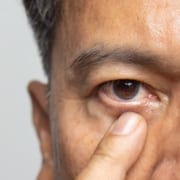Constant Eye Twitching? What Blepharospasm Is and How It’s Treated
Occasional eye twitching is common and usually harmless. However, when it becomes frequent, disruptive, or interferes with daily life, it may be a sign of a more serious condition called blepharospasm. This neurological disorder causes involuntary muscle spasms around the eyes, affecting both comfort and appearance.
Dr. Dennis Maehara founded Maehara Eye Clinic over 30 years ago, and today, care is led by his son, Dr. Jeffrey Maehara, a board-certified ophthalmologist and fellowship-trained specialist in anterior segment and glaucoma. He also brings expertise in preventive and integrative care as a fellowship-trained physician in anti-aging regenerative medicine.
With advanced treatment options available, those suffering from chronic eye twitching don’t need to live with the discomfort.
What Is Blepharospasm?
Blepharospasm is a condition characterized by involuntary muscle contractions around the eyes. Unlike minor twitches that subside quickly, this condition causes repetitive blinking or even involuntary eyelid closures. These spasms can occur in both eyes and may worsen over time.
Blepharospasm is believed to result from abnormal nerve activity in the brain’s movement control centers, although its exact origin is uncertain. It is more common in adults over the age of 40 and tends to affect women more frequently than men.
When to Be Concerned About Eye Twitching
Not all twitching is a cause for alarm. However, there are key signs that may indicate a more serious condition:
- Frequent, uncontrollable blinking or spasms in both eyes
- Twitching that spreads to other areas of the face
- Eyelids that close involuntarily, affecting vision
- Increased twitching during stress, fatigue, or bright light
Persistent symptoms or any impact on your ability to go about daily life should prompt a visit to an eye care specialist.
Blepharospasm Treatment Options
Treatment for blepharospasm typically begins with targeted muscle-relaxing injections that reduce spasms by interrupting the nerve signals causing them. One commonly used option is Xeomin, which provides temporary relief that lasts approximately three to four months.
Other treatment approaches may include:
- Oral medications that help regulate muscle activity, though these are used less often
- Surgical procedures such as myectomy, which involves removing specific muscles or nerves when less invasive methods are no longer effective
The right approach can significantly ease discomfort and restore a more relaxed, natural look around the eyes.
Managing Chronic Eye Twitching in Honolulu, HI
Living with constant eye twitching can take a toll on both comfort and confidence. Fortunately, effective, specialized care for blepharospasm is available right here in Honolulu. With the right diagnosis and treatment plan, it’s possible to regain control and feel more at ease in daily life.
Don’t wait for symptoms to worsen. Schedule a consultation today to explore your treatment options and take the first step toward lasting relief. Contact us at 808-955-3937 to speak with a member of the team and book your appointment.

